Charles E W Bean, Diaries, AWM38 3DRL 606/254/1 - 1917 - 1933 - Part 21
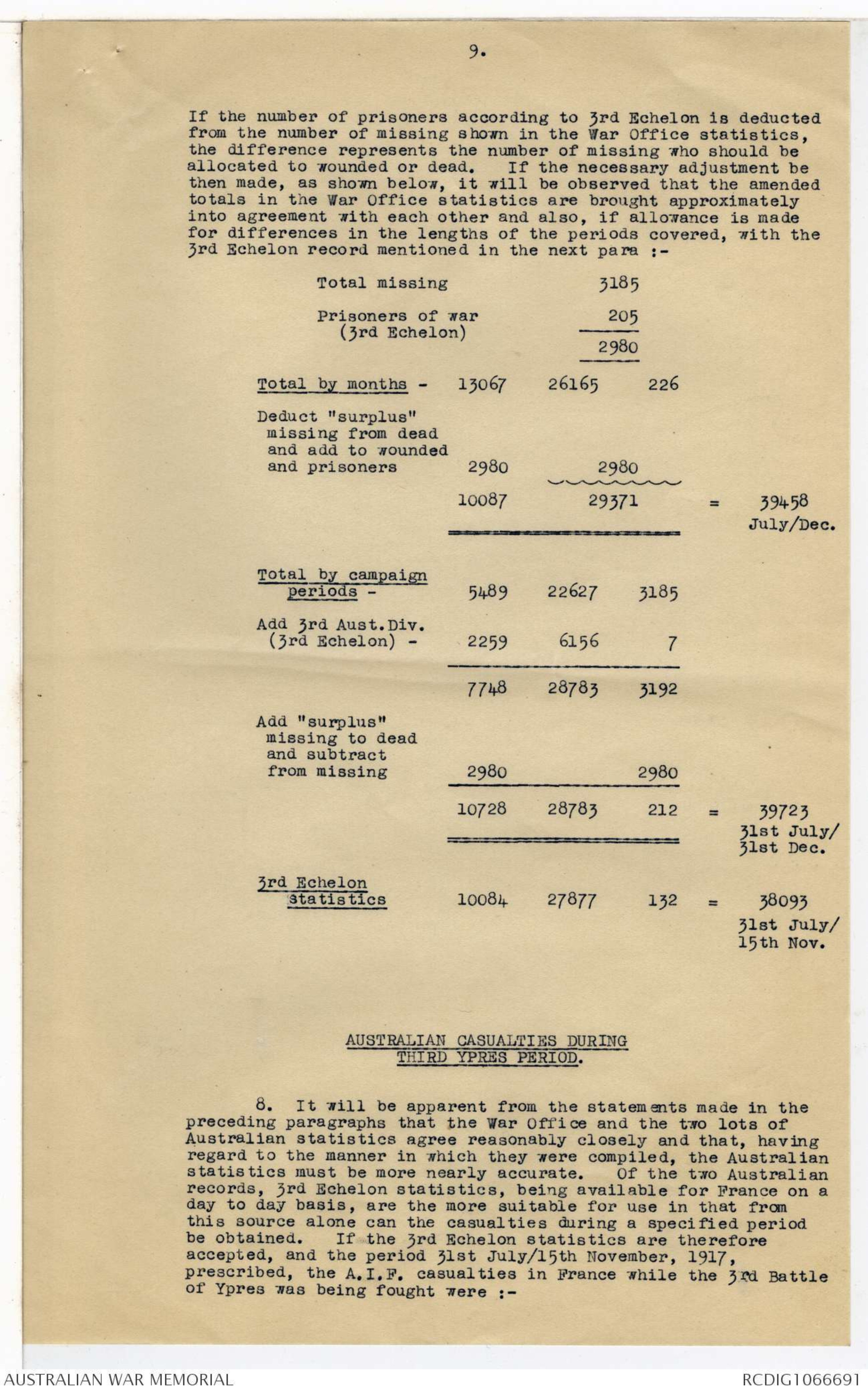
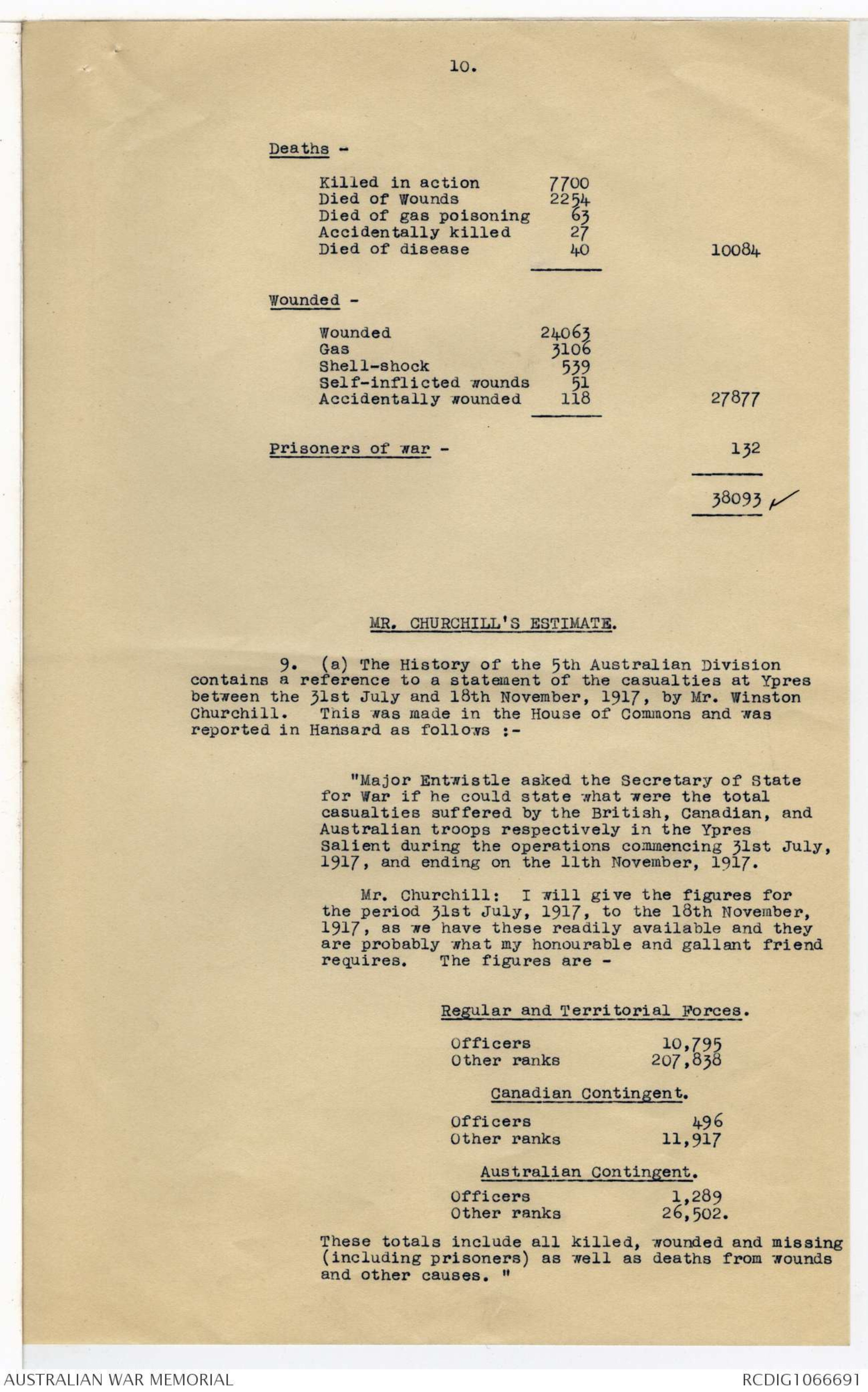
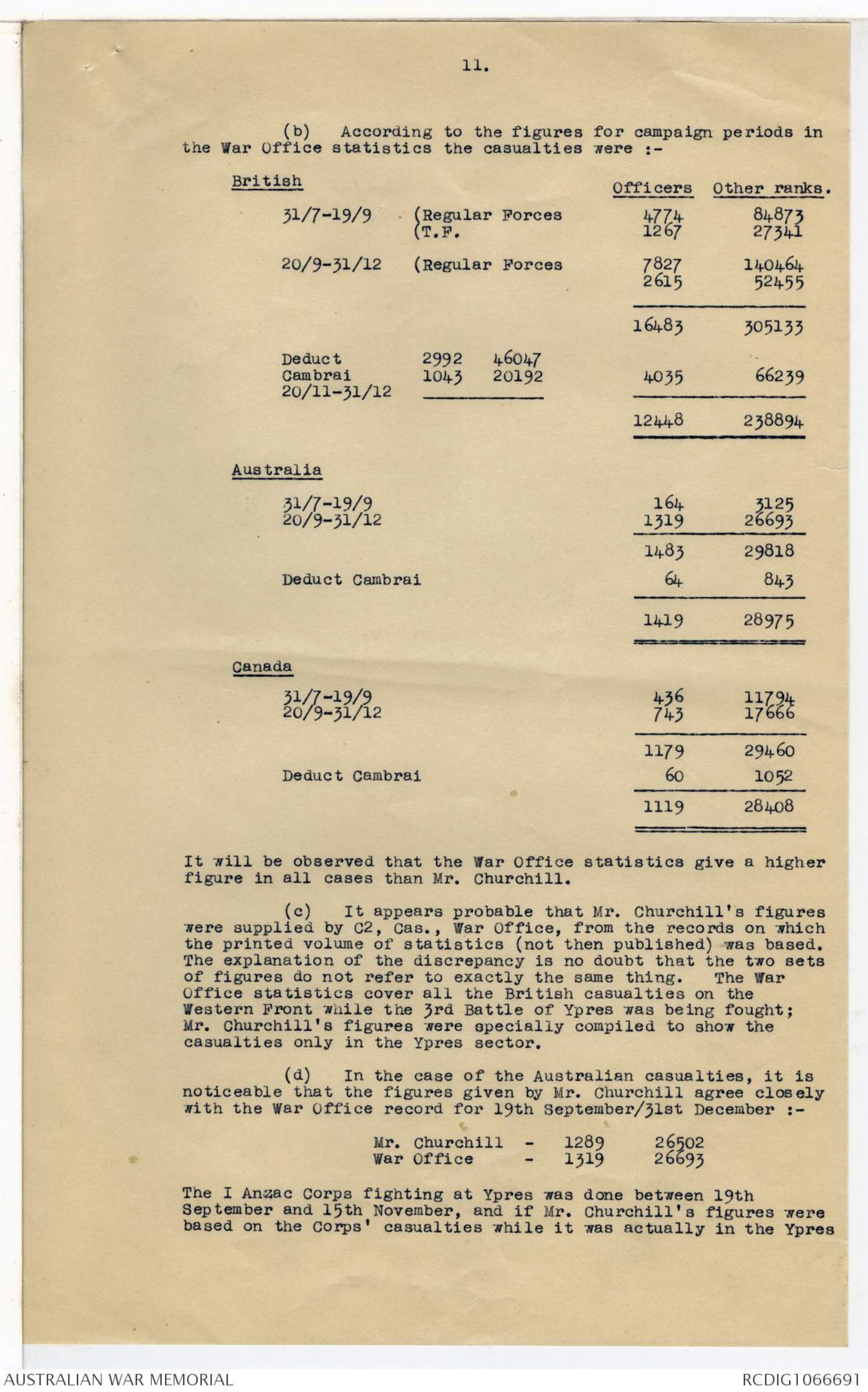
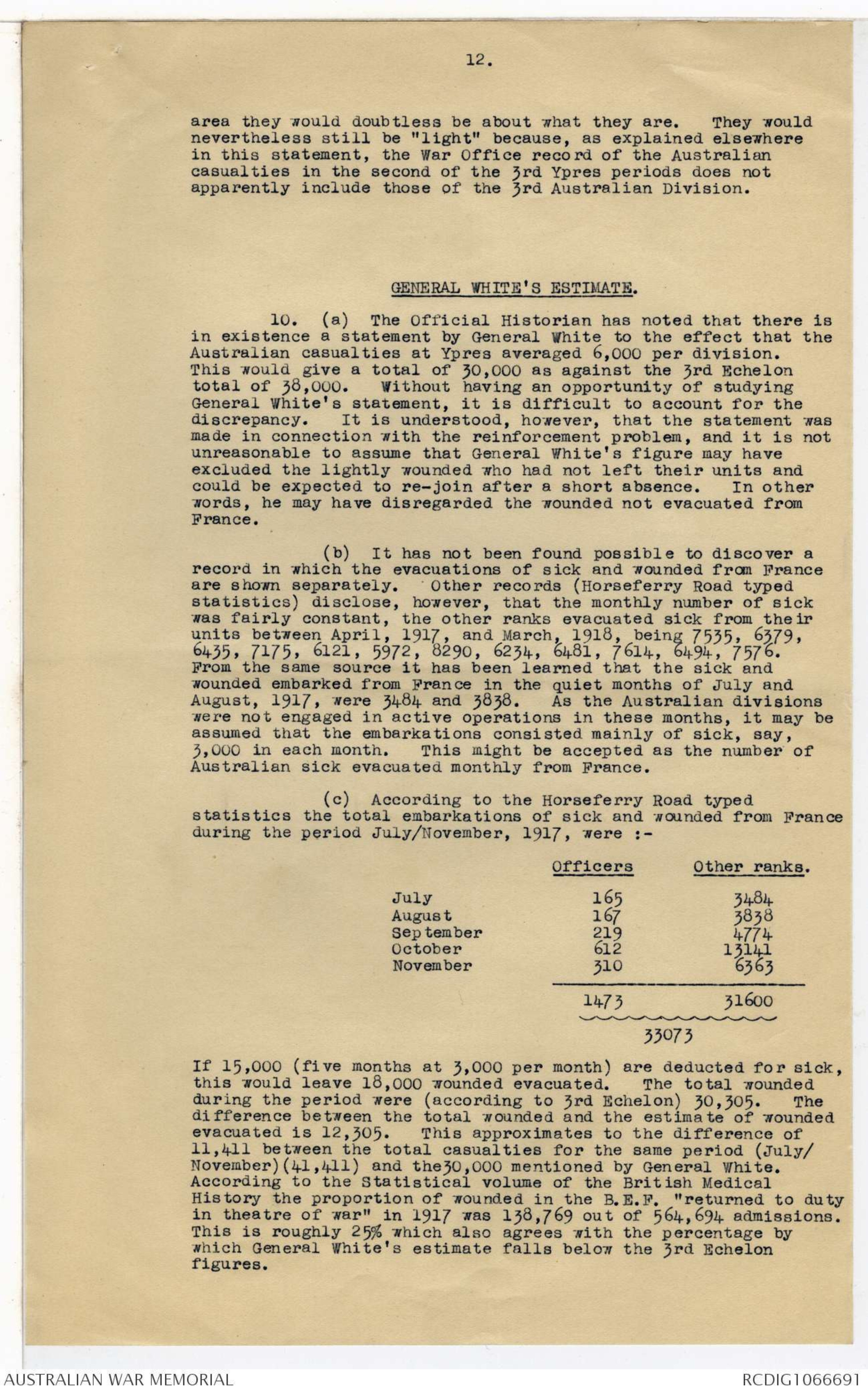
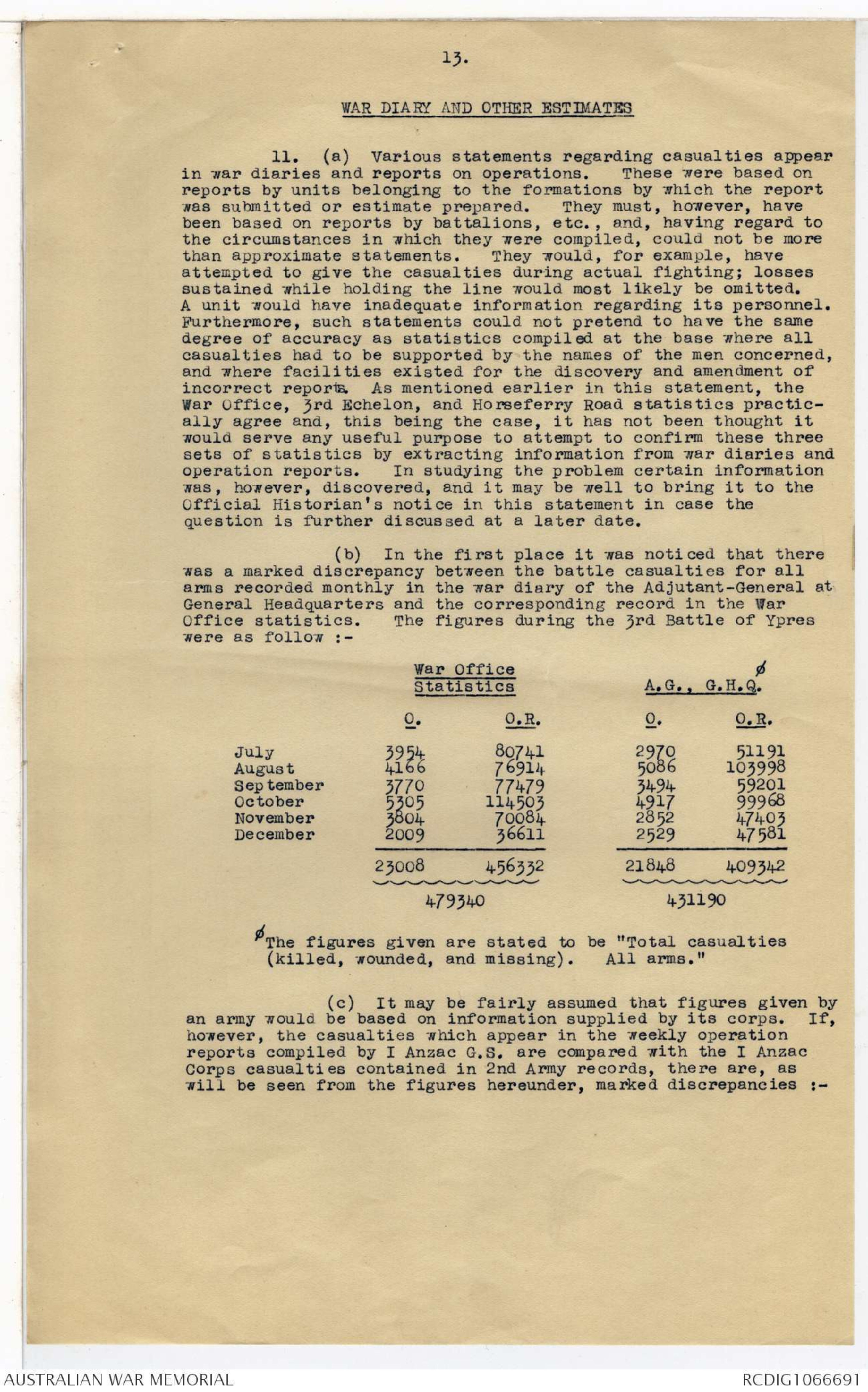
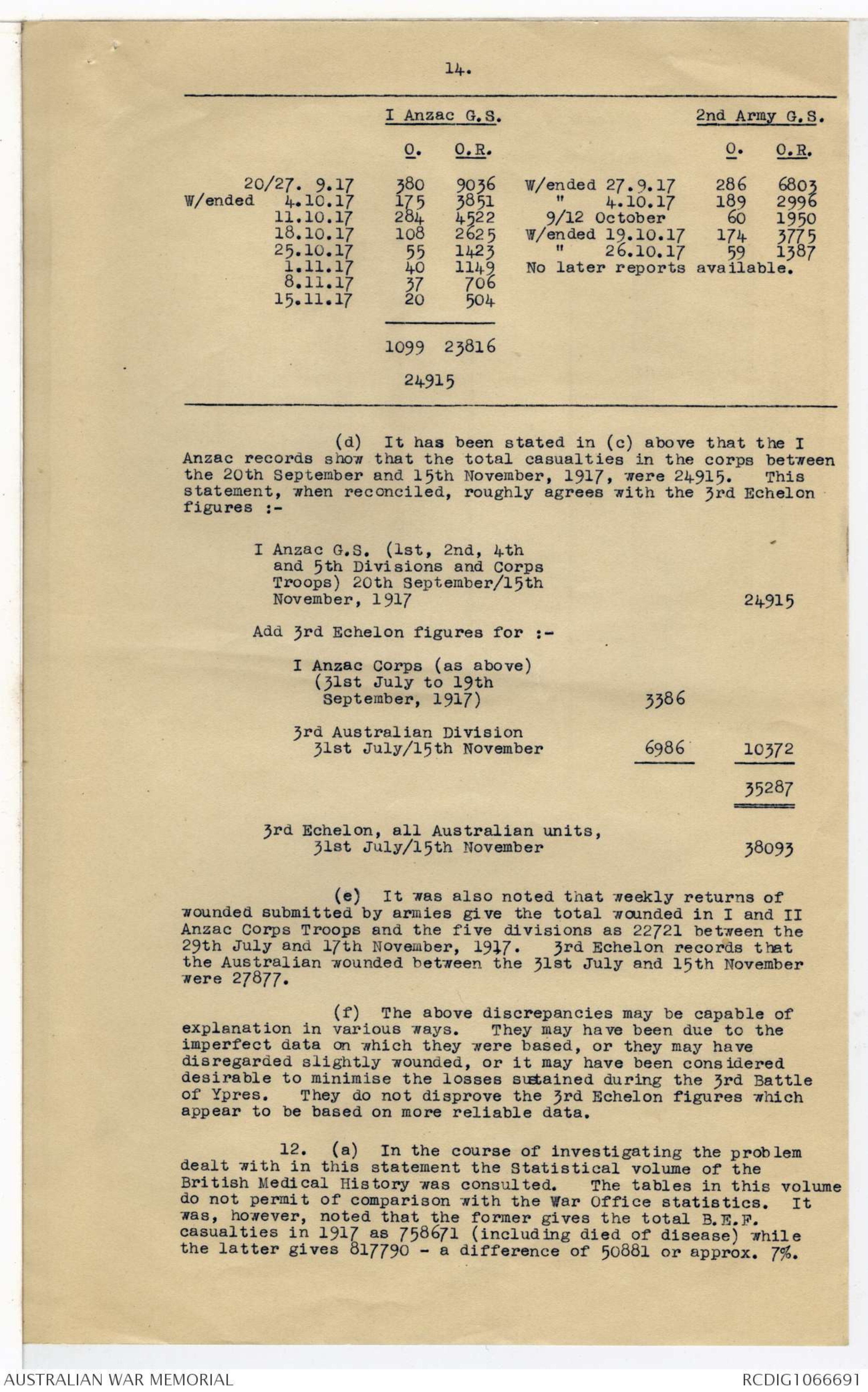
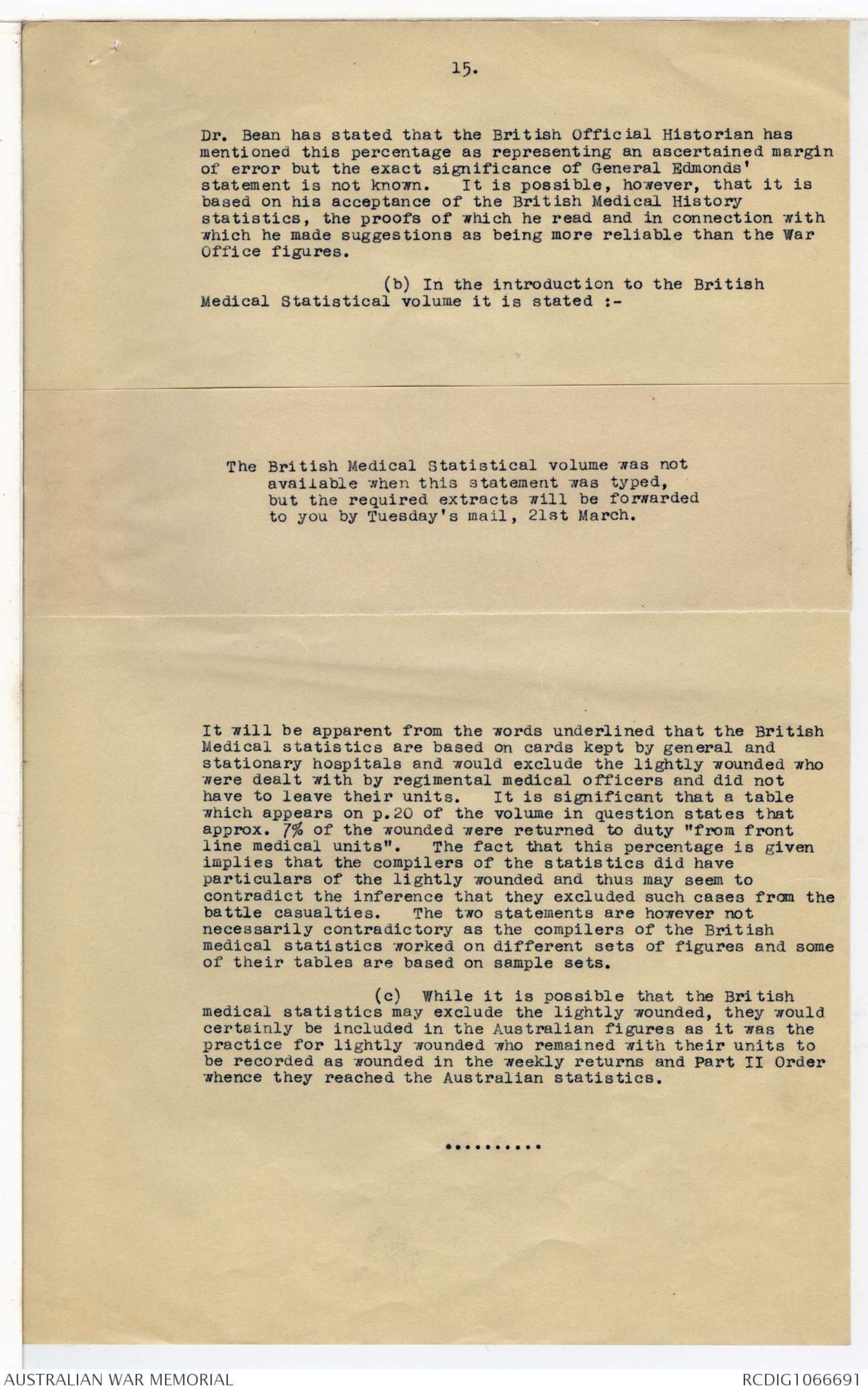
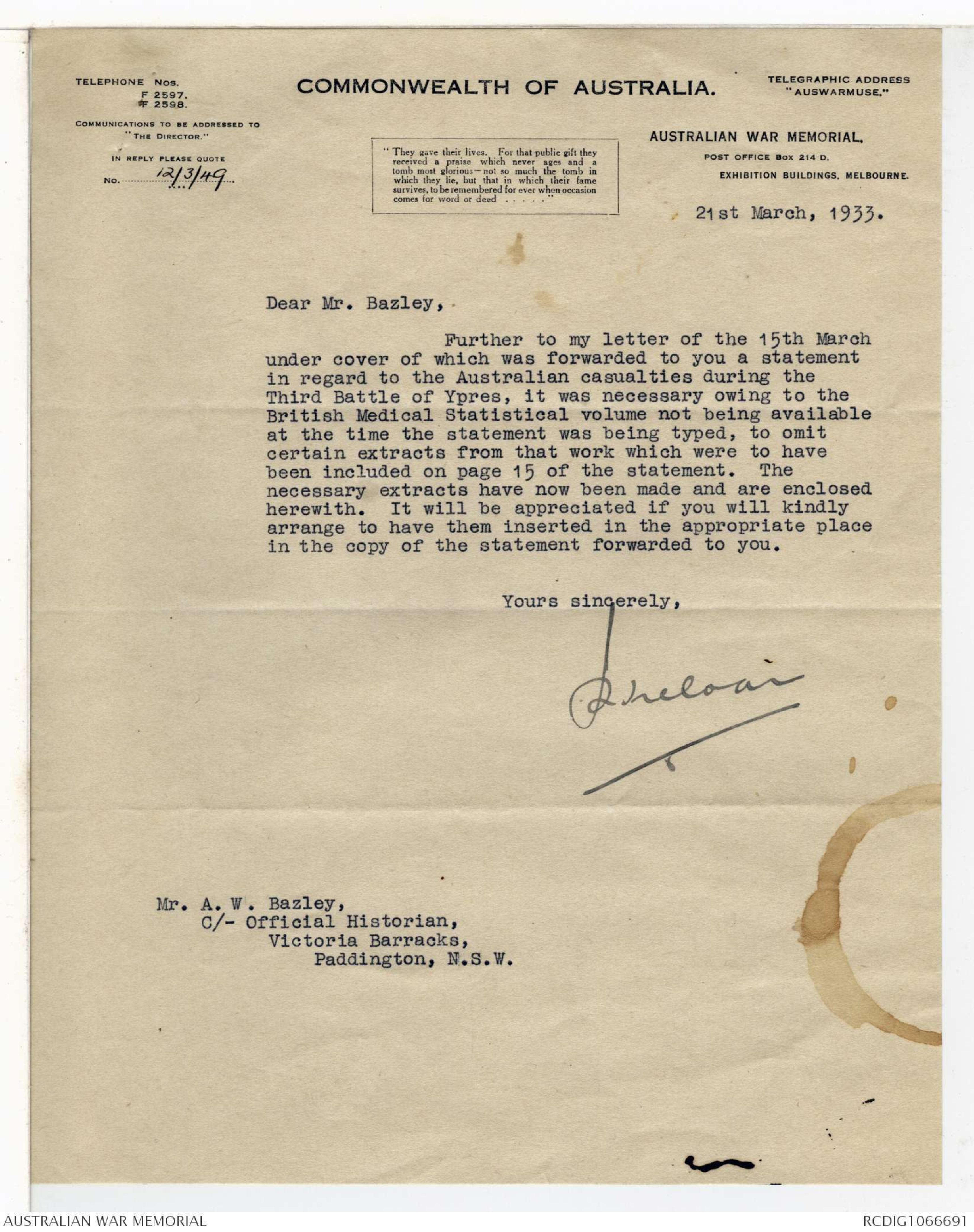
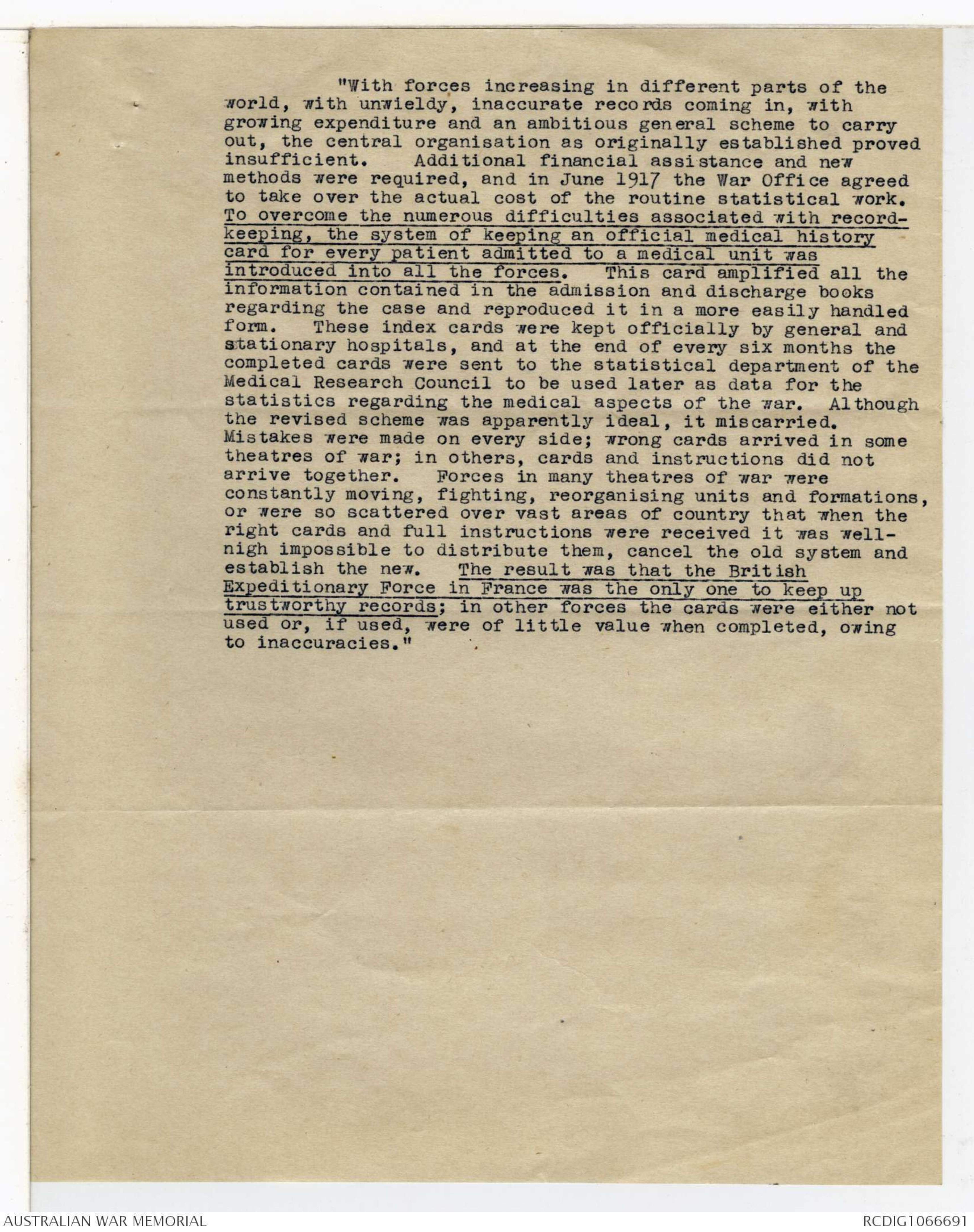
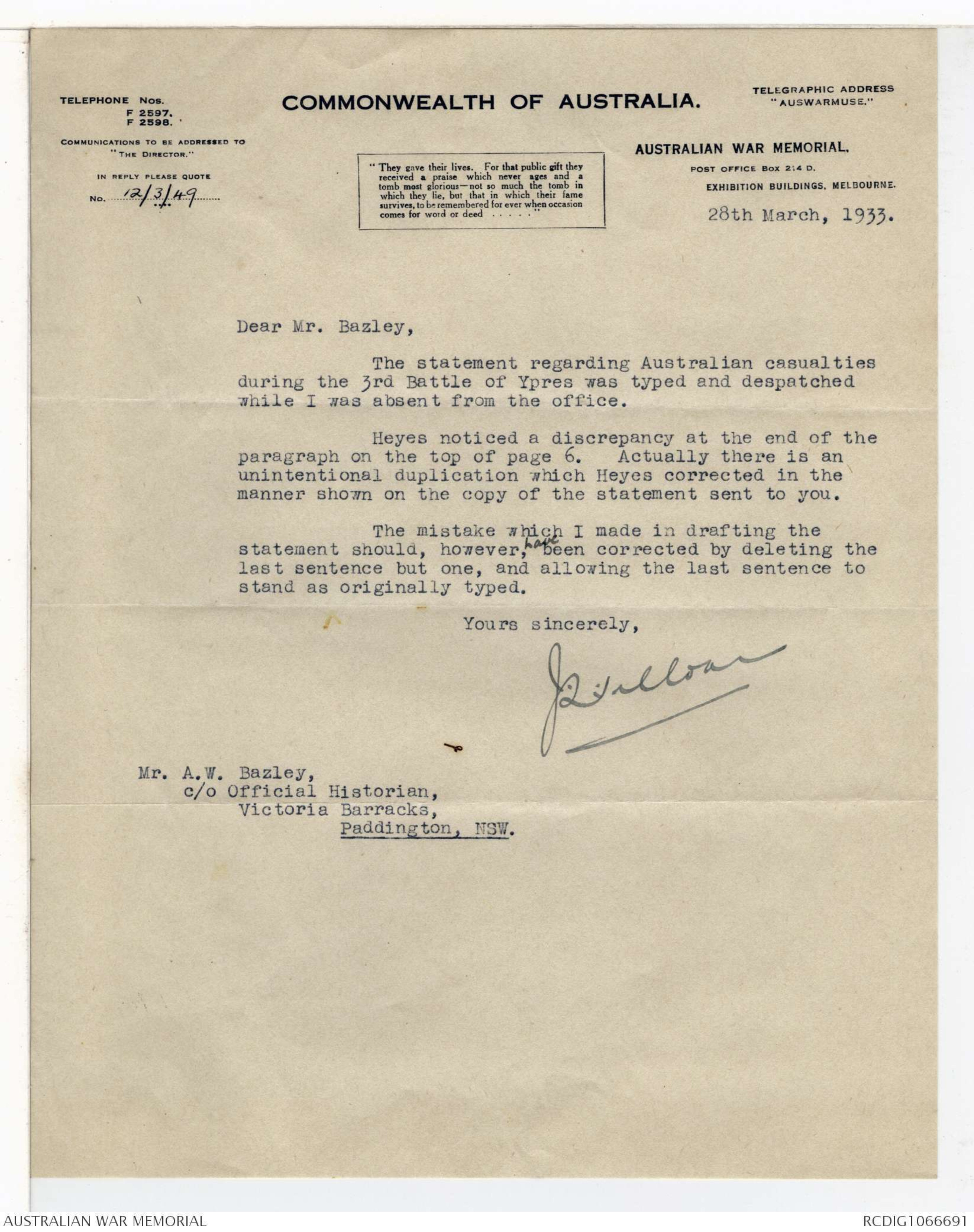
9.
If the number of prisoners according to 3rd Echelon is deducted
from the number of missing shown in the War Office statistics,
the difference represents the number of missing who should be
allocated to wounded or dead. If the necessary adjustment be
then made, as shown below, it will be observed that the amended
totals in the War Office statistics are brought approximately
into agreement with each other and also, if allowance is made
for differences in the lengths of the periods covered, with the
3rd Echelon record mentioned in the next para :-
Total missing 3185
Prisoners of war
(3rd Echelon) 205
2980
Total by months - 13067 26165 226
Deduct "surplus"
missing from dead
and add to wounded
and prisoners 2980 2980
10087 29371 = 39458
July/Dec.
Total by campaign
periods - 5489 22627 3185
Add 3rd Aust.Div.
(3rd Echelon) - 2259 6156 7
7748 28783 3192
Add "surplus"
missing to dead
and subtract
from missing 2980 2980
10728 28783 212 = 39723
31st July/
31st Dec.
3rd Echelon
statistics 10084 27877 132 = 38093
31st July/
15th Nov.
AUSTRALIAN CASUALTIES DURING
THIRD YPRES PERIOD.
8. It will be apparent from the statements made in the
preceding paragraphs that the War Office and the two lots of
Australian statistics agree reasonably closely and that, having
regard to the manner in which they were compiled, the Australian
statistics must be more nearly accurate. Of the two Australian
records, 3rd Echelon statistics, being available for France on a
day to day basis, are the more suitable for use in that from
this source alone can the casualties during a specified period
be obtained. If the 3rd Echelon statistics are therefore
accepted, and the period 31st July/15th November, 1917,
prescribed, the A.I.F. casualties in France while the 3rd Battle
of Ypres was being fought were:-
10.
Deaths -
Killed in action 7700
Died of Wounds 2254
Died of gas poisoning 63
Accidentally killed 27
Died of disease 40 10084
Wounded -
Wounded 24063
Gas 3106
Shell-shock 539
Self-inflicted wounds 51
Accidentally wounded 118 27877
Prisoners of war - 132
38093 ✓
MR. CHURCHILL'S ESTIMATE.
9. (a) The History of the 5th Australian Division
contains a reference to a statement of the casualties at Ypres
between the 31st July and 18th November, 1917, by Mr. Winston
Churchill. This was made in the House of Commons and was
reported in Hansard as follows :-
"Major Entwistle asked the Secretary of State
for War if he could state what were the total
casualties suffered by the British, Canadian, and
Australian troops respectively in the Ypres
Salient during the operations commencing 31st July,
1917, and ending on the 11th November, 1917.
Mr. Churchill: I will give the figures for
the period 31st July, 1917, to the 18th November,
1917, as we have these readily available and they
are probably what my honourable and gallant friend
requires. The figures are -
Regular and Territorial Forces.
Officers 10,795
Other ranks 207,838
Canadian Contingent.
Officers 496
Other ranks 11,917
Australian Contingent.
Officers 1,289
Other ranks 26,502.
These totals include all killed, wounded and missing
(including prisoners) as well as deaths from wounds
and other causes. "
11.
(b) According to the figures for campaign periods in
the War Office statistics the casualties were :-
British Officers Other ranks.
31/7-19/9 (Regular Forces 4474 84873
(T.F. 1267 27341
20/9-31/12 (Regular Forces 7827 140464
2615 52455
16483 305133
Deduct 2992 46047
Cambrai 1043 20192 4035 66239
20/11-31/12 12448 238894
Australia
31/7-19/9 164 3125
20/9-31/12 1319 26693
1483 29818
Deduct Cambrai 64 843
1419 28975
Canada
31/7-19/9 436 11794
20/9-31/12 743 17666
1179 29460
Deduct Cambrai 60 1052
1119 28408
It will be observed that the War Office statistics give a higher
figure in all cases than Mr. Churchill.
(c) It appears probable that Mr. Churchill's figures
were supplied by C2, Cas., War Office, from the records on which
the printed volume of statistics (not then published) was based.
The explanation of the discrepancy is no doubt that the two sets
of figures do not refer to exactly the same thing. The War
Office statistics cover all the British casualties on the
Western Front while the 3rd Battle of Ypres was being fought;
Mr. Churchill's figures were specially compiled to show the
casualties only in the Ypres sector.
(d) In the case of the Australian casualties, it is
noticeable that the figures given by Mr. Churchill agree closely
with the War Office record for 19th September/3lst December:-
Mr. Churchill - 1289 26502
War Office - 1319 26693
The I Anzac Corps fighting at Ypres was done between 19th
September and 15th November, and if Mr. Churchill's figures were
based on the Corps' casualties while it was actually in the Ypres
12.
area they would doubtless be about what they are. They would
nevertheless still be "light" because, as explained elsewhere
in this statement, the War Office record of the Australian
casualties in the second of the 3rd Ypres periods does not
apparently include those of the 3rd Australian Division.
GENERAL WHITE'S ESTIMATE.
10. (a) The Official Historian has noted that there is
in existence a statement by General White to the effect that the
Australian casualties at Ypres averaged 6,000 per division.
This would give a total of 30,000 as against the 3rd Echelon
total of 38,000. Without having an opportunity of studying
General White's statement, it is difficult to account for the
discrepancy. It is understood, however, that the statement was
made in connection with the reinforcement problem, and it is not
unreasonable to assume that General White's figure may have
excluded the lightly wounded who had not left their units and
could be expected to re-join after a short absence. In other
words, he may have disregarded the wounded not evacuated from
France.
(b) It has not been found possible to discover a
record in which the evacuations of sick and wounded from France
are shown separately. Other records (Horseferry Road typed
statistics) disclose, however, that the monthly number of sick
was fairly constant, the other ranks evacuated sick from their
units between April, 1917, and March, 1918, being 7535, 6379,
6435, 7175, 6121, 5972, 8290, 6234, 6481, 7614, 6494, 7576.
From the same source it has been learned that the sick and
wounded embarked from France in the quiet months of July and
August, 1917, were 3484 and 3838. As the Australian divisions
were not engaged in active operations in these months, it may be
assumed that the embarkations consisted mainly of sick, say,
3,000 in each month. This might be accepted as the number of
Australian sick evacuated monthly from France.
(c) According to the Horseferry Road typed
statistics the total embarkations of sick and wounded from France
during the period July/November, 1917, were:-
Officers Other ranks.
July 165 3484
August 167 3838
September 219 4774
October 612 13141
November 310 6363
1473 31600
33073
If 15,000 (five months at 3,000 per month) are deducted for sick,
this would leave 18,000 wounded evacuated. The total wounded
during the period were (according to 3rd Echelon) 30,305. The
difference between the total wounded and the estimate of wounded
evacuated is 12,305. This approximates to the difference of
11,411 between the total casualties for the same period (July/
November) (41,41l) and the 30,000 mentioned by General White.
According to the Statistical volume of the British Medical
History the proportion of wounded in the B.E.F. "returned to duty
in theatre of war" in 1917 was 138,769 out of 564,694 admissions.
This is roughly 25% which also agrees with the percentage by
which General White's estimate falls below the 3rd Echelon
figures.
13.
WAR DIARY AND OTHER ESTIMATES
11. (a) Various statements regarding casualties appear
in war diaries and reports on operations. These were based on
reports by units belonging to the formations by which the report
was submitted or estimate prepared. They must, however, have
been based on reports by battalions, etc., and, having regard to
the circumstances in which they were compiled, could not be more
than approximate statements. They would, for example, have
attempted to give the casualties during actual fighting; losses
sustained while holding the line would most likely be omitted.
A unit would have inadequate information regarding its personnel.
Furthermore, such statements could not pretend to have the same
degree of accuracy as statistics compiled at the base where all
casualties had to be supported by the names of the men concerned,
and where facilities existed for the discovery and amendment of
incorrect reports. As mentioned earlier in this statement, the
War Office, 3rd Echelon, and Horseferry Road statistics practically
agree and, this being the case, it has not been thought it
would serve any useful purpose to attempt to confirm these three
sets of statistics by extracting information from war diaries and
operation reports. In studying the problem certain information
was, however, discovered, and it may be well to bring it to the
Official Historian's notice in this statement in case the
question is further discussed at a later date.
(b) In the first place it was noticed that there
was a marked discrepancy between the battle casualties for all
arms recorded monthly in the war diary of the Adjutant-General at
General Headquarters and the corresponding record in the War
Office statistics. The figures during the 3rd Battle of Ypres
were as follow:-
War Office
Statistics A.G., G.H.Q.#
O. O.R. O. O.R.
July 3954 80741 2970 51191
August 4166 76914 5086 103998
September 3770 77479 3494 59201
October 5305 114503 4917 99968
November 3804 70084 2852 47403
December 2009 36611 2529 47581
23008 456332 21848 409342
479340 431190
#The figures given are stated to be "Total casualties
(killed, wounded, and missing). All arms."
(c) It may be fairly assumed that figures given by
an army would be based on information supplied by its corps. If,
however, the casualties which appear in the weekly operation
reports compiled by I Anzac G.S. are compared with the I Anzac
Corps casualties contained in 2nd Army records, there are, as
will be seen from the figures hereunder, marked discrepancies:-
14.
I Anzac G.S. 2nd Army G.S.
O. O.R. O. O.R.
20/27. 9.17 380 9036 W/ended 27.9.17 286 6803
W/ended 4.10.17 175 3851 " 4.10.17 189 2996
11.10.17 284 4522 9/12 October 60 1950
18.10.17 108 2625 W/ended 19.10.17 174 3775
25.10.17 55 1423 " 26.10.17 59 1387
1.11.17 40 1149 No later reports available.
8.11.17 37 706
15.11.17 20 504
1099 23816
24915
(d) It has been stated in (c) above that the I
Anzac records show that the total casualties in the corps between
the 20th September and 15th November, 1917, were 24915. This
statement, when reconciled, roughly agrees with the 3rd Echelon
figures :-
I Anzac G.S. (1st, 2nd, 4th
and 5th Divisions and Corps
Troops) 20th September/15th
November, 1917 24915
Add 3rd Echelon figures for:-
I Anzac Corps (as above)
(31st July to 19th
September, 1917) 3386
3rd Australian Division
31st July/15th November 6986 10372
35287
3rd Echelon, all Australian units,
31st July/15th November 38093
(e) It was also noted that weekly returns of
wounded submitted by armies give the total wounded in I and II
Anzac Corps Troops and the five divisions as 22721 between the
29th July and 17th November, 1917. 3rd Echelon records that
the Australian wounded between the 31st July and 15th November
were 27877.
(f) The above discrepancies may be capable of
explanation in various ways. They may have been due to the
imperfect data on which they were based, or they may have
disregarded slightly wounded, or it may have been considered
desirable to minimise the losses sustained during the 3rd Battle
of Ypres. They do not disprove the 3rd Echelon figures which
appear to be based on more reliable data.
12. (a) In the course of investigating the problem
dealt with in this statement the Statistical volume of the
British Medical History was consulted. The tables in this volume
do not permit of comparison with the War Office statistics. It
was, however, noted that the former gives the total B.E.F.
casualties in 1917 as 758671 (including died of disease) while
the latter gives 817790 - a difference of 50881 or approx. 7%.
15.
Dr. Bean has stated that the British Official Historian has
mentioned this percentage as representing an ascertained margin
of error but the exact significance of General Edmonds'
statement is not known. It is possible, however, that it is
based on his acceptance of the British Medical History
statistics, the proofs of which he read and in connection with
which he made suggestions as being more reliable than the War
Office figures.
(b) In the introduction to the British
Medical Statistical volume it is stated :-
The British Medical Statistical volume was not
available when this statement was typed,
but the required extracts will be forwarded
to you by Tuesday's mail, 21st March.
It will be apparent from the words underlined that the British
Medical statistics are based on cards kept by general and
stationary hospitals and would exclude the lightly wounded who
were dealt with by regimental medical officers and did not
have to leave their units. It is significant that a table
which appears on p. 20 of the volume in question states that
approx. 7% of the wounded were returned to duty "from front
line medical units". The fact that this percentage is given
implies that the compilers of the statistics did have
particulars of the lightly wounded and thus may seem to
contradict the inference that they excluded such cases from the
battle casualties. The two statements are however not
necessarily contradictory as the compilers of the British
medical statistics worked on different sets of figures and some
of their tables are based on sample sets.
(c) While it is possible that the British
medical statistics may exclude the lightly wounded, they would
certainly be included in the Australian figures as it was the
practice for lightly wounded who remained with their units to
be recorded as wounded in the weekly returns and Part II Order
whence they reached the Australian statistics.
TELEPHONE Nos.
F 2597.
F 2598.
COMMONWEALTH OF AUSTRALIA.
TELEGRAPHIC ADDRESS
"AUSWARMUSE."
COMMUNICATIONS TO BE ADDRESSED TO
"THE DIRECTOR."
IN REPLY PLEASE QUOTE
No. 12/3/49
AUSTRALIAN WAR MEMORIAL,
POST OFFICE BOX 214 D.
EXHIBITION BUILDINGS, MELBOURNE.
"They gave their lives. For that public gift they
received a praise which never ages and a
tomb most glorious - not so much the tomb in
which they lie, but that in which their fame
survives, to be remembered for ever when occasion
comes for word or deed....."
21st March, 1933.
Dear Mr. Bazley,
Further to my letter of the 15th March
under cover of which was forwarded to you a statement
in regard to the Australian casualties during the
Third Battle of Ypres, it was necessary owing to the
British Medical Statistical volume not being available
at the time the statement was being typed, to omit
certain extracts from that work which were to have
been included on page 15 of the statement. The
necessary extracts have now been made and are enclosed
herewith. It will be appreciated if you will kindly
arrange to have them inserted in the appropriate place
in the copy of the statement forwarded to you.
Yours sincerely,
JRTreloar
Mr. A. W. Bazley,
C/- Official Historian,
Victoria Barracks,
Paddington, N.S.W.
"With forces increasing in different parts of the
world, with unwieldy, inaccurate records coming in, with
growing expenditure and an ambitious general scheme to carry
out, the central organisation as originally established proved
insufficient. Additional financial assistance and new
methods were required, and in June 1917 the War Office agreed
to take over the actual cost of the routine statistical work.
To overcome the numerous difficulties associated with record-keeping,
the system of keeping an official medical history
card for every patient admitted to a medical unit was
introduced into all the forces. This card amplified all the
information contained in the admission and discharge books
regarding the case and reproduced it in a more easily handled
form. These index cards were kept officially by general and
stationary hospitals, and at the end of every six months the
completed cards were sent to the statistical department of the
Medical Research Council to be used later as data for the
statistics regarding the medical aspects of the war. Although
the revised scheme was apparently ideal, it miscarried.
Mistakes were made on every side; wrong cards arrived in some
theatres of war; in others, cards and instructions did not
arrive together. Forces in many theatres of war were
constantly moving, fighting, reorganising units and formations,
or were so scattered over vast areas of country that when the
right cards and full instructions were received it was well-nigh
impossible to distribute them, cancel the old system and
establish the new. The result was the British
Expeditionary Force in France was the only one to keep up
trustworthy records; in other forces the cards were either not
used or, if used, were of little value when completed, owing
to inaccuracies."
TELEPHONE Nos.
F 2597.
F 2598.
COMMONWEALTH OF AUSTRALIA.
TELEGRAPHIC ADDRESS
"AUSWARMUSE"
COMMUNICATIONS TO BE ADDRESSED TO
"THE DIRECTOR"
IN REPLY PLEASE QUOTE
No. 12/3/49
AUSTRALIAN WAR MEMORIAL,
POST OFFICE BOX 214 D.
EXHIBITION BUILDINGS, MELBOURNE.
"They gave their lives. For that public gift they
received a praise which never ages and a
tomb most glorious - not so much the tomb in
which they lie, but that in which their fame
survives, to be remembered for ever when occasion
comes for word or deed....."
28th March, 1933.
Dear Mr. Bazley,
The statement regarding Australian casualties
during the 3rd Battle of Ypres was typed and despatched
while I was absent from the office.
Heyes noticed a discrepancy at the end of the
paragraph on the top of page 6. Actually there is an
unintentional duplication which Heyes corrected in the
manner shown on the copy of the statement sent to you.
The mistake which I made in drafting the
statement should, however, have been corrected by deleting the
last sentence but one, and allowing the last sentence to
stand as originally typed.
Yours sincerely,
JRTreloar
Mr. A.W. Bazley,
c/o Official Historian,
Victoria Barracks,
Paddington, NSW
 Deb Parkinson
Deb ParkinsonThis transcription item is now locked to you for editing. To release the lock either Save your changes or Cancel.
This lock will be automatically released after 60 minutes of inactivity.